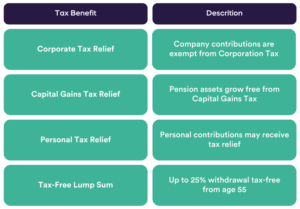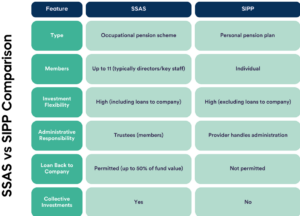
What are the disadvantages of a SSAS pension?
While SSAS pensions offer numerous benefits, they also come with certain disadvantages that potential members should consider:
-
Complex Regulatory Responsibilities
Being a trustee of a SSAS means you are jointly responsible for ensuring the scheme complies with all HMRC regulations and pension laws. This includes accurate record-keeping, timely reporting, and adherence to investment rules. The complexity of these responsibilities can be daunting, especially for those without experience in pension administration.
- Risk of Penalties: Failure to comply with regulations can result in significant penalties or tax charges from HMRC.
- Administrative Burden: The ongoing management can be time-consuming, potentially diverting attention from running your business.
-
Unanimous Decision-Making Required
All members of a SSAS are also trustees and must therefore agree on investment decisions and scheme management matters. This requirement for unanimous agreement can pose challenges, particularly when there are multiple members with differing opinions.
- Potential for Disputes: Differences in investment strategies or business objectives among trustees can lead to conflicts.
- Decision Delays: Reaching consensus may slow down decision-making processes, which can hinder timely investment opportunities.
-
Limited Number of Members
A SSAS can accommodate up to 11 members, which typically includes company directors and key staff. This means that businesses will still need to operate Automatic Enrolment pension schemes for other employees.
- Exclusivity: Because all decisions need to be unanimous, it is typical to limit members of a SSAS to the business owners, directors and key staff
- Family-Owned Businesses: In family-run businesses, including multiple generations might be challenging within the member limit.
- Growth Constraints: As your business expands, adding new members to the SSAS may require restructuring or setting up additional schemes.
What is the difference between a SSAS pension and SIPPs?
Both SSAS and Self-Invested Personal Pensions (SIPPs) offer investment flexibility, but key differences can influence which is better for your business needs.
Run by Members vs. Run by Provider
A fundamental difference lies in who runs the scheme:
- SSAS: Run by and for its members, typically company directors or key staff. As trustees, members have direct control over investment decisions and scheme management. This setup provides autonomy and the ability to tailor the pension scheme to your business and members.
- SIPP: Run by a pension provider. While you control your investment choices within the options provided, the provider handles overall administration and management. This simplifies the process but may limit customization and control compared to a SSAS.
Example: Imagine the difference between being a chef and dining out:
- SSAS: You’re the chef in your own kitchen—you design the menu, pick the ingredients, and cook the meal to your taste. Every aspect is under your control, allowing you to create a dining experience tailored precisely to you.
- SIPP: You’re dining at a restaurant—you choose a dish from the menu, but the chef (the provider) decides how it’s prepared. While you have options to select from, you’re relying on the chef’s expertise and the restaurant’s offerings. Control over the meal is ultimately in the chef’s hands.
Cost Considerations
A SSAS can be more expensive to run than a SIPP due to additional administrative responsibilities and professional fees. However, if multiple members join the SSAS, costs are spread among them, potentially making the per-member cost similar to that of a full-service SIPP.
- SSAS Costs: Include setup fees, annual administration fees, and fees for professional trustees. These costs are offset by benefits like greater control and collective investment opportunities.
- SIPP Costs: Generally lower annual fees, as the provider handles administration for many accounts. Costs can increase depending on investment choices and transactions.
Death Benefits and Commercial Property Ownership
A significant difference between SSAS and SIPP arises in how death benefits are handled, especially when the pension scheme owns commercial property used by the business.
Example: Suppose both a SSAS and a SIPP own commercial property—a building used as business premises for the company.
- In a SIPP: When a member dies, the scheme pays death benefits to the beneficiary’s pension arrangement. This may require selling or refinancing the commercial property to release funds. Selling a key business asset could disrupt operations, and refinancing can be costly.
- In a SSAS: The deceased member’s funds can remain within the scheme. Beneficiaries can join the SSAS as new members, or existing members can share the benefits among themselves. You don’t need to sell or refinance the commercial property, ensuring business continuity. The property remains an asset of the pension scheme, allowing uninterrupted use by the business.
This approach in a SSAS helps avoid liquidating assets or disrupting investments to meet immediate liabilities. It provides stability for your business and beneficiaries.

Understanding these differences is crucial in determining which pension scheme aligns best with your business and retirement goals.
Setting Up a SSAS Pension
How to Set Up a SSAS Pension for Your Business?
Here’s how a SSAS works: your company (or companies), set up a registered pension scheme and become joint administrators.
There is usually a corporate trustee appointed too – in the case of the Hartsfield SSAS this is White Horse Trustees Ltd. This corporate trustee will act as a scheme administrator alongside you. Although having a corporate trustee is no longer a legal requirement, most SSAS schemes use them to ensure that all scheme procedures and investments are carried out within HM Revenue & Customs guidelines.
The administrator (usually the corporate trustee) will be responsible for registering the SSAS with HMRC and providing the required information to scheme members, HMRC and The Pensions Regulator. Additionally; as a data controller, the scheme will also be registered with the Information Commissioner’s Office (ICO).
You can then invite up to 11 key members of your staff and, in certain circumstances, family members to join. All members of the scheme will also be trustees and decisions need to be taken together and unanimously.
While it may sound daunting, we can guide you through the SSAS setup process. The key is to work with experienced professionals who understand the intricacies of pension law and HMRC requirements.
Trustee Responsibilities
As a trustee of your SSAS, you must manage the scheme in accordance with pension regulations. This includes making prudent investment decisions, ensuring compliance with reporting obligations, and acting in the best interests of all members. While this adds responsibility, it grants you direct control over your retirement funds.
Keeping you in control of your SSAS Pension
A Small Self-Administered Scheme (SSAS) pension offers impressive flexibility and unique advantages for company directors and business owners. From investing in commercial property to enjoying significant tax benefits and even passing assets to future generations, a SSAS can be a powerful tool for your retirement planning.
However, managing a SSAS comes with responsibilities, and it’s crucial to navigate these complexities with the right support. At Hartsfield, we specialize in helping business owners set up and manage SSAS pensions effectively, ensuring that your retirement strategy aligns with both your business and personal goals. Get in touch with us today for expert guidance—let’s take the next step towards securing your financial future together.
 Planning
Planning Investment
Investment

